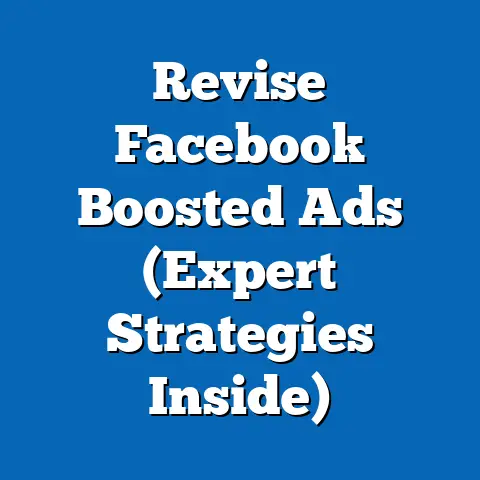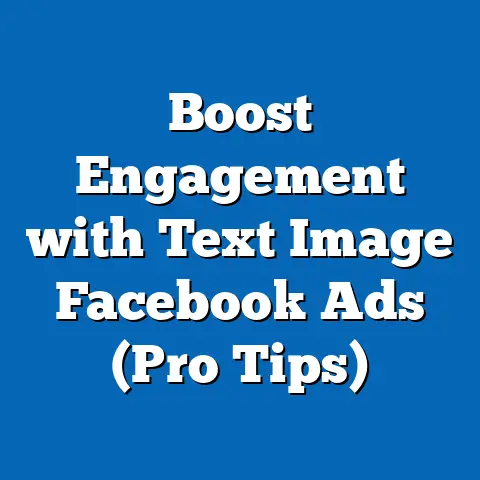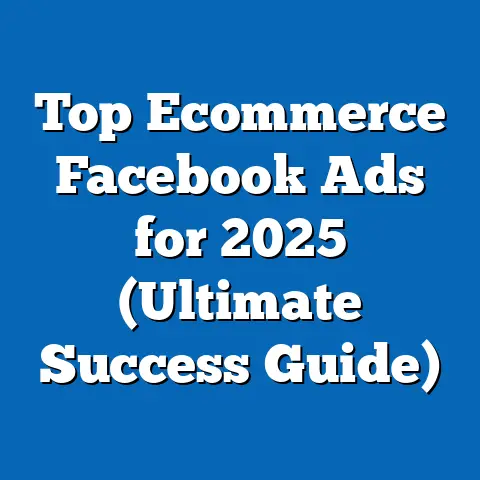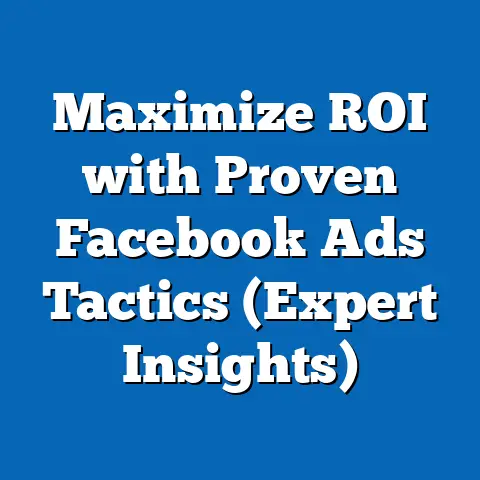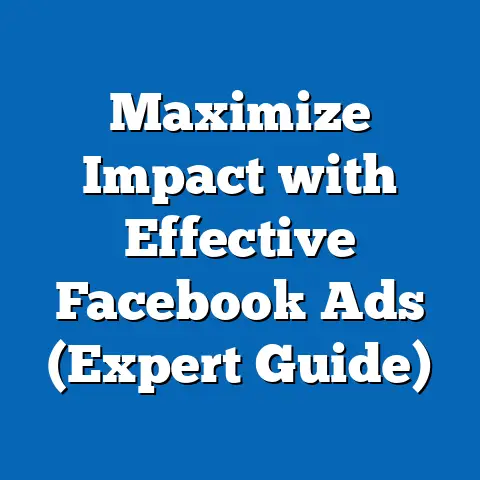Mastering Facebook Ad Block (Ultimate Guide to Privacy)
Digital advertising has revolutionized the way businesses connect with potential customers. Platforms like Facebook have become powerhouses, offering unparalleled reach and targeting capabilities. However, this innovation has also sparked a global conversation about user privacy. As a digital marketing specialist with years of experience navigating the Facebook ecosystem, I’ve seen firsthand how the platform has evolved and the growing concerns surrounding data usage. Today, I’m going to walk you through the world of Facebook Ad Block – what it is, how to master it, and what it means for both users and businesses.
Let’s dive into the world of Facebook advertising, where I will clarify how it works and the types of ads available.
Understanding Facebook Ads
Facebook’s advertising platform is a marvel of modern technology, connecting businesses with billions of users worldwide. It’s not just about throwing an ad out there and hoping for the best; it’s about precision targeting and engagement. Let’s break down the key components:
-
Ad Types: Facebook offers a wide variety of ad formats to suit different marketing goals. These include:
- Image Ads: Simple, visually appealing ads featuring a single image and a concise message. Perfect for brand awareness and showcasing products.
- Video Ads: Engaging ads that capture attention with motion and sound. Ideal for storytelling and product demonstrations.
- Carousel Ads: Showcase multiple products or features in a single ad unit. Great for e-commerce and highlighting different aspects of a service.
- Collection Ads: Designed for mobile shopping, these ads feature a main video or image with related products displayed below.
- Lead Ads: Collect leads directly from Facebook without sending users to an external website. Useful for building email lists and gathering customer information.
- Instant Experience Ads: Full-screen, mobile-optimized ads that offer an immersive experience.
-
The Algorithm Behind Ad Targeting: The heart of Facebook’s advertising effectiveness lies in its sophisticated algorithm. This algorithm analyzes vast amounts of user data to match ads with the most relevant audience. The data points include:
-
Demographics: Age, gender, location, education, and other basic information.
- Interests: Pages liked, groups joined, topics engaged with, and other indications of user preferences.
- Behaviors: Purchase history, online activity, device usage, and other behavioral patterns.
- Connections: Friends, family, and other social connections.
- User Engagement and Ad Effectiveness: User engagement is crucial for ad success. Facebook’s algorithm rewards ads that generate positive interactions (likes, comments, shares, clicks) by showing them to more people. Ads with low engagement may be penalized with higher costs or reduced reach. Therefore, creating compelling content that resonates with the target audience is essential.
Ad Types: Facebook offers a wide variety of ad formats to suit different marketing goals. These include:
- Image Ads: Simple, visually appealing ads featuring a single image and a concise message. Perfect for brand awareness and showcasing products.
- Video Ads: Engaging ads that capture attention with motion and sound. Ideal for storytelling and product demonstrations.
- Carousel Ads: Showcase multiple products or features in a single ad unit. Great for e-commerce and highlighting different aspects of a service.
- Collection Ads: Designed for mobile shopping, these ads feature a main video or image with related products displayed below.
- Lead Ads: Collect leads directly from Facebook without sending users to an external website. Useful for building email lists and gathering customer information.
- Instant Experience Ads: Full-screen, mobile-optimized ads that offer an immersive experience.
-
The Algorithm Behind Ad Targeting: The heart of Facebook’s advertising effectiveness lies in its sophisticated algorithm. This algorithm analyzes vast amounts of user data to match ads with the most relevant audience. The data points include:
-
Demographics: Age, gender, location, education, and other basic information.
- Interests: Pages liked, groups joined, topics engaged with, and other indications of user preferences.
- Behaviors: Purchase history, online activity, device usage, and other behavioral patterns.
- Connections: Friends, family, and other social connections.
- User Engagement and Ad Effectiveness: User engagement is crucial for ad success. Facebook’s algorithm rewards ads that generate positive interactions (likes, comments, shares, clicks) by showing them to more people. Ads with low engagement may be penalized with higher costs or reduced reach. Therefore, creating compelling content that resonates with the target audience is essential.
The Algorithm Behind Ad Targeting: The heart of Facebook’s advertising effectiveness lies in its sophisticated algorithm. This algorithm analyzes vast amounts of user data to match ads with the most relevant audience. The data points include:
Demographics: Age, gender, location, education, and other basic information.
Key Takeaway: Facebook advertising offers a powerful way to reach specific audiences, but it relies heavily on data collection and user engagement. Understanding these fundamentals is crucial for both advertisers and users concerned about privacy.
Now, let’s move on to the growing privacy concerns that have fueled the rise of ad-blocking technologies.
The Rise of Privacy Concerns
In recent years, awareness around online privacy has skyrocketed. Several factors have contributed to this shift, including high-profile data breaches, increased media coverage of data privacy issues, and the introduction of privacy-focused regulations.
- Recent Events and Legislation: Landmark regulations like the General Data Protection Regulation (GDPR) in Europe and the California Consumer Privacy Act (CCPA) in the United States have empowered users with greater control over their personal data. These laws require companies to be transparent about data collection practices and provide users with the ability to access, correct, and delete their data.
- Data Breaches and Scandals: The Cambridge Analytica scandal, where data from millions of Facebook users was harvested without their consent, served as a wake-up call for many. It highlighted the potential for misuse of personal data and the importance of protecting online privacy. Other data breaches involving major companies have further eroded public trust in social media platforms.
- Rise of Ad-Blocking Technologies: As privacy concerns have grown, so has the popularity of ad-blocking technologies. Millions of users worldwide now use ad blockers to prevent websites and social media platforms from tracking their online activity and serving them personalized ads. This trend reflects a growing desire for greater control over online experiences and a rejection of intrusive advertising practices.
Key Takeaway: Increased awareness of online privacy issues, coupled with high-profile data breaches and regulatory changes, has led to a surge in the use of ad-blocking technologies. This has significant implications for businesses that rely on Facebook advertising.
Let’s explore what Facebook Ad Block is and how it works.
What is Facebook Ad Block?
Facebook Ad Block refers to the various methods and tools users employ to block or limit the ads they see on the platform. It’s not a single feature offered by Facebook, but rather a collection of third-party tools and techniques.
- Definition and Function: Ad blockers work by identifying and blocking the code and scripts that serve ads on websites and social media platforms. They use filter lists and algorithms to detect and remove ad elements, preventing them from loading on the user’s screen.
-
Types of Ad-Blocking Tools: Several types of ad-blocking tools are available, including:
- Browser Extensions: Add-ons for web browsers like Chrome, Firefox, and Safari that block ads on all websites, including Facebook. Popular examples include AdBlock, Adblock Plus, and uBlock Origin. I personally use uBlock Origin because of its efficiency and low resource usage.
- Privacy-Focused Browsers: Web browsers like Brave and Tor that have built-in ad-blocking and privacy features. These browsers offer enhanced protection against tracking and data collection.
- VPNs with Ad Blocking: Some Virtual Private Networks (VPNs) offer ad-blocking capabilities as part of their service. These VPNs block ads at the network level, providing protection across all devices connected to the VPN.
-
Popularity and Motivations: Ad blockers have become increasingly popular among users who are concerned about:
-
Intrusive Ads: Many users find personalized ads to be intrusive and annoying, especially when they track their online activity across multiple websites.
- Privacy: Ad blockers prevent Facebook and other platforms from collecting data about their browsing habits and interests.
- Security: Some ads can be malicious and contain malware or phishing links. Ad blockers can help protect users from these threats.
- Performance: Ads can slow down page loading times and consume bandwidth. Ad blockers can improve browsing speed and reduce data usage.
Types of Ad-Blocking Tools: Several types of ad-blocking tools are available, including:
- Browser Extensions: Add-ons for web browsers like Chrome, Firefox, and Safari that block ads on all websites, including Facebook. Popular examples include AdBlock, Adblock Plus, and uBlock Origin. I personally use uBlock Origin because of its efficiency and low resource usage.
- Privacy-Focused Browsers: Web browsers like Brave and Tor that have built-in ad-blocking and privacy features. These browsers offer enhanced protection against tracking and data collection.
- VPNs with Ad Blocking: Some Virtual Private Networks (VPNs) offer ad-blocking capabilities as part of their service. These VPNs block ads at the network level, providing protection across all devices connected to the VPN.
-
Popularity and Motivations: Ad blockers have become increasingly popular among users who are concerned about:
-
Intrusive Ads: Many users find personalized ads to be intrusive and annoying, especially when they track their online activity across multiple websites.
- Privacy: Ad blockers prevent Facebook and other platforms from collecting data about their browsing habits and interests.
- Security: Some ads can be malicious and contain malware or phishing links. Ad blockers can help protect users from these threats.
- Performance: Ads can slow down page loading times and consume bandwidth. Ad blockers can improve browsing speed and reduce data usage.
Popularity and Motivations: Ad blockers have become increasingly popular among users who are concerned about:
Intrusive Ads: Many users find personalized ads to be intrusive and annoying, especially when they track their online activity across multiple websites.
Key Takeaway: Facebook Ad Block encompasses a range of tools and techniques that users employ to block or limit ads on the platform. These tools are driven by concerns about privacy, security, and performance.
Now, let’s get into the practical aspects of mastering Facebook Ad Block.
How to Master Facebook Ad Block
Mastering Facebook Ad Block involves installing and configuring the right tools and customizing settings to achieve the desired level of privacy without sacrificing the overall user experience.
-
Step-by-Step Guide to Installation and Configuration:
- Choose an Ad Blocker: Select an ad blocker that meets your needs and preferences. Consider factors like ease of use, features, and performance.
- Install the Ad Blocker: Download and install the ad blocker extension from your browser’s app store (e.g., Chrome Web Store, Firefox Add-ons).
- Configure Settings: Customize the ad blocker’s settings to block ads on Facebook. Most ad blockers have default settings that block most ads, but you can adjust these settings to fine-tune your experience.
- Update Filter Lists: Regularly update the ad blocker’s filter lists to ensure that it can block the latest ads and tracking scripts.
-
Customizing Settings for Enhanced Privacy:
-
Block Third-Party Trackers: Enable settings that block third-party trackers, which are used to collect data about your browsing habits across multiple websites.
- Disable Social Media Buttons: Disable social media buttons (like the Facebook “Like” button) on websites to prevent Facebook from tracking your activity outside of its platform.
- Use a Privacy-Focused Search Engine: Switch to a privacy-focused search engine like DuckDuckGo, which doesn’t track your searches or personalize your results based on your search history.
-
Whitelisting Ads or Pages:
-
Support Websites You Value: Consider whitelisting websites that you value and want to support. This allows ads to be displayed on those websites, providing them with revenue to continue creating content.
- Whitelist Specific Ads: Some ad blockers allow you to whitelist specific ads that you find relevant or interesting. This can help you support businesses while still maintaining a degree of privacy.
Step-by-Step Guide to Installation and Configuration:
- Choose an Ad Blocker: Select an ad blocker that meets your needs and preferences. Consider factors like ease of use, features, and performance.
- Install the Ad Blocker: Download and install the ad blocker extension from your browser’s app store (e.g., Chrome Web Store, Firefox Add-ons).
- Configure Settings: Customize the ad blocker’s settings to block ads on Facebook. Most ad blockers have default settings that block most ads, but you can adjust these settings to fine-tune your experience.
- Update Filter Lists: Regularly update the ad blocker’s filter lists to ensure that it can block the latest ads and tracking scripts.
-
Customizing Settings for Enhanced Privacy:
-
Block Third-Party Trackers: Enable settings that block third-party trackers, which are used to collect data about your browsing habits across multiple websites.
- Disable Social Media Buttons: Disable social media buttons (like the Facebook “Like” button) on websites to prevent Facebook from tracking your activity outside of its platform.
- Use a Privacy-Focused Search Engine: Switch to a privacy-focused search engine like DuckDuckGo, which doesn’t track your searches or personalize your results based on your search history.
-
Whitelisting Ads or Pages:
-
Support Websites You Value: Consider whitelisting websites that you value and want to support. This allows ads to be displayed on those websites, providing them with revenue to continue creating content.
- Whitelist Specific Ads: Some ad blockers allow you to whitelist specific ads that you find relevant or interesting. This can help you support businesses while still maintaining a degree of privacy.
Customizing Settings for Enhanced Privacy:
Block Third-Party Trackers: Enable settings that block third-party trackers, which are used to collect data about your browsing habits across multiple websites.
Whitelisting Ads or Pages:
Support Websites You Value: Consider whitelisting websites that you value and want to support. This allows ads to be displayed on those websites, providing them with revenue to continue creating content.
Key Takeaway: Mastering Facebook Ad Block involves installing and configuring ad-blocking tools, customizing settings for enhanced privacy, and whitelisting ads or pages to support websites you value.
Now, let’s examine how ad blocking impacts businesses advertising on Facebook.
The Impact of Ad Blocking on Businesses
The rise of ad blocking has significant implications for businesses that rely on Facebook advertising to reach their target audiences.
- Potential Loss of Revenue and Engagement: Ad blockers prevent ads from being displayed to users, resulting in a potential loss of revenue for businesses. They also reduce engagement metrics like impressions, clicks, and conversions. According to a 2023 report by Statista, ad blocking cost publishers nearly $49 billion in revenue globally.
-
Alternative Advertising Strategies: Businesses can employ alternative advertising strategies to reach audiences despite the presence of ad blockers. These include:
- Native Advertising: Creating ads that blend seamlessly with the surrounding content. Native ads are less likely to be blocked by ad blockers because they don’t look like traditional ads.
- Influencer Marketing: Partnering with social media influencers to promote products or services. Influencer marketing can be effective because it relies on trusted voices and authentic content.
- Content Marketing: Creating valuable and engaging content that attracts and retains customers. Content marketing can help businesses build brand awareness and establish themselves as thought leaders.
- Email Marketing: Building an email list and sending targeted messages to subscribers. Email marketing can be a cost-effective way to reach customers and promote products or services.
-
Improving Ad Relevance and User Experience: By creating more relevant and engaging ads, businesses can reduce the likelihood that users will block them. This involves:
-
Targeting the Right Audience: Using Facebook’s targeting options to reach the most relevant audience for their ads.
- Creating Compelling Content: Developing ads that are visually appealing, informative, and engaging.
- Avoiding Intrusive Ad Formats: Using less intrusive ad formats, such as native ads or sponsored posts.
Alternative Advertising Strategies: Businesses can employ alternative advertising strategies to reach audiences despite the presence of ad blockers. These include:
- Native Advertising: Creating ads that blend seamlessly with the surrounding content. Native ads are less likely to be blocked by ad blockers because they don’t look like traditional ads.
- Influencer Marketing: Partnering with social media influencers to promote products or services. Influencer marketing can be effective because it relies on trusted voices and authentic content.
- Content Marketing: Creating valuable and engaging content that attracts and retains customers. Content marketing can help businesses build brand awareness and establish themselves as thought leaders.
- Email Marketing: Building an email list and sending targeted messages to subscribers. Email marketing can be a cost-effective way to reach customers and promote products or services.
-
Improving Ad Relevance and User Experience: By creating more relevant and engaging ads, businesses can reduce the likelihood that users will block them. This involves:
-
Targeting the Right Audience: Using Facebook’s targeting options to reach the most relevant audience for their ads.
- Creating Compelling Content: Developing ads that are visually appealing, informative, and engaging.
- Avoiding Intrusive Ad Formats: Using less intrusive ad formats, such as native ads or sponsored posts.
Improving Ad Relevance and User Experience: By creating more relevant and engaging ads, businesses can reduce the likelihood that users will block them. This involves:
Targeting the Right Audience: Using Facebook’s targeting options to reach the most relevant audience for their ads.
Key Takeaway: Ad blocking can lead to a loss of revenue and engagement for businesses. However, by employing alternative advertising strategies and improving ad relevance, businesses can mitigate the impact of ad blockers.
Now, let’s look into the future of Facebook ads and privacy.
The Future of Facebook Ads and Privacy
The future of Facebook advertising is likely to be shaped by ongoing privacy concerns and technological advancements.
-
Potential Changes by Facebook: Facebook may implement changes to address privacy concerns while still providing value to advertisers. These could include:
- Enhanced Privacy Controls: Providing users with more granular control over their data and how it’s used for advertising.
- Transparent Data Practices: Being more transparent about data collection practices and how data is used for ad targeting.
- Privacy-Preserving Advertising Technologies: Developing new advertising technologies that protect user privacy while still allowing businesses to reach their target audiences.
-
The Balance Between Advertising and Privacy: Striking the right balance between effective advertising and user privacy will be crucial for the long-term success of Facebook and other social media platforms. This involves:
-
Respecting User Preferences: Allowing users to control their data and choose whether or not to see personalized ads.
- Being Transparent About Data Practices: Clearly communicating how data is collected and used for advertising.
- Providing Value to Users: Creating ads that are relevant, informative, and engaging.
- Technological Advancements: New technologies like differential privacy and federated learning could enable businesses to personalize ads without directly accessing user data. These technologies work by analyzing aggregated data while protecting the privacy of individual users.
Potential Changes by Facebook: Facebook may implement changes to address privacy concerns while still providing value to advertisers. These could include:
- Enhanced Privacy Controls: Providing users with more granular control over their data and how it’s used for advertising.
- Transparent Data Practices: Being more transparent about data collection practices and how data is used for ad targeting.
- Privacy-Preserving Advertising Technologies: Developing new advertising technologies that protect user privacy while still allowing businesses to reach their target audiences.
-
The Balance Between Advertising and Privacy: Striking the right balance between effective advertising and user privacy will be crucial for the long-term success of Facebook and other social media platforms. This involves:
-
Respecting User Preferences: Allowing users to control their data and choose whether or not to see personalized ads.
- Being Transparent About Data Practices: Clearly communicating how data is collected and used for advertising.
- Providing Value to Users: Creating ads that are relevant, informative, and engaging.
- Technological Advancements: New technologies like differential privacy and federated learning could enable businesses to personalize ads without directly accessing user data. These technologies work by analyzing aggregated data while protecting the privacy of individual users.
The Balance Between Advertising and Privacy: Striking the right balance between effective advertising and user privacy will be crucial for the long-term success of Facebook and other social media platforms. This involves:
Respecting User Preferences: Allowing users to control their data and choose whether or not to see personalized ads.
Key Takeaway: The future of Facebook advertising will depend on striking a balance between effective advertising and user privacy. Technological advancements and changes in user expectations will play a significant role in shaping this future.
Conclusion
Understanding Facebook Ad Block and its implications is essential for both users and advertisers. As users become more concerned about online privacy, they are increasingly turning to ad-blocking technologies to protect their data and control their online experiences. Businesses, on the other hand, need to adapt their advertising strategies to reach audiences despite the presence of ad blockers.
The ongoing dialogue and innovation in the realm of digital advertising and privacy are crucial for creating a sustainable ecosystem that benefits both users and businesses. By respecting user preferences, being transparent about data practices, and providing value to users, Facebook and other social media platforms can build trust and maintain long-term relationships with their audiences.
As you navigate the evolving landscape of social media advertising, remember to stay informed, take control of your online experiences, and advocate for a future where privacy and effective advertising can coexist. I hope this guide has provided you with the knowledge and tools you need to master Facebook Ad Block and make informed decisions about your online privacy.

